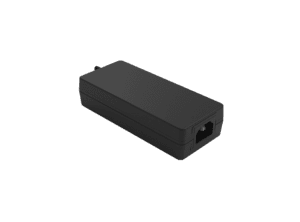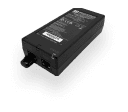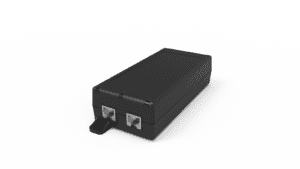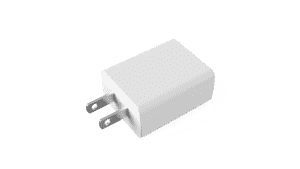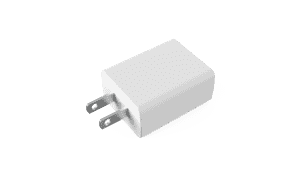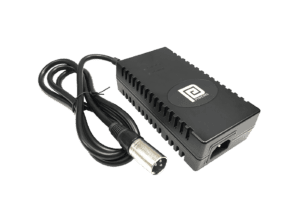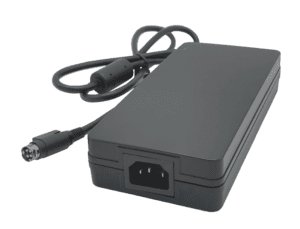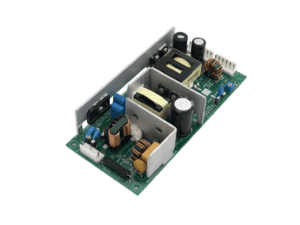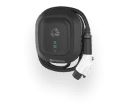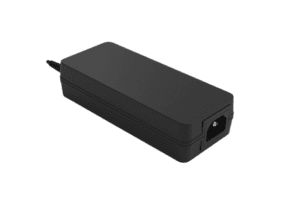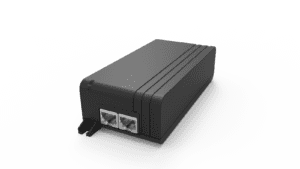BLOG
PoE Standards: Understanding Energy Efficiency Standards for PoE Injectors
Table of contents

Power over Ethernet (PoE) technology has become a crucial component of modern network infrastructure. It delivers both power and data through a single Ethernet cable, eliminating the need for devices (like cameras) to be near a power outlet. As this technology evolves, so do the associated technical, safety, and efficiency standards. This article aims to familiarize you with the importance of PoE standards and guide you in choosing the right one.
What Are PoE Standards?
The PoE landscape is defined by a set of standards established by the Institute of Electrical and Electronics Engineers (IEEE). These standards govern how power is transmitted over Ethernet cables, ensuring compatibility and safety across various devices.
IEEE 802.3af
The IEEE 802.3af standard, introduced in 2003, was the first to define Power over Ethernet. It allows devices to receive up to 15.4 watts of power over a standard Category 5 (Cat 5) cable. This standard was groundbreaking, enabling the deployment of low-power devices such as IP cameras and VoIP phones without the need for additional power sources. The 802.3af standard established the foundation for subsequent PoE standards, paving the way for more powerful applications.
Key features of IEEE 802.3af include:
- Power Classification: Devices are classified into different power classes based on their power requirements, ensuring that PoE switches can allocate power efficiently.
- Detection and Classification: PoE switches can automatically detect whether a connected device is PoE-compatible, preventing power delivery to non-PoE devices.
IEEE 802.3at
In 2009, the IEEE 802.3at standard, also known as PoE+, expanded upon the capabilities of the original standard. With a maximum power output of 30 watts, PoE+ supports more power-hungry devices, including advanced wireless access points and pan-tilt-zoom cameras. This standard maintains backward compatibility with 802.3af devices, allowing for seamless integration of new and existing equipment.
Key enhancements of IEEE 802.3at include:
- Increased Power Delivery: The ability to deliver up to 30 watts enables support for devices requiring more energy, such as high-definition IP cameras.
- Improved Power Management: PoE+ devices can negotiate power requirements, ensuring efficient power distribution and minimizing waste.
IEEE 802.3bt
The latest standard, IEEE 802.3bt, was introduced in 2018 and further increased power delivery capabilities to a maximum of 60 watts (Type 3) and 90 watts (Type 4). This advancement allows PoE to power high-performance devices such as video conferencing systems, digital signage, and even LED lighting systems.
Key innovations in IEEE 802.3bt include:
- Higher Power Levels: The ability to deliver more power opens up new possibilities for PoE applications, supporting devices that were previously unable to utilize PoE.
- Multi-Channel Power Delivery: Type 4 PoE injectors can deliver power over all four pairs of wires in a Cat 5e or Cat 6 cable, enhancing efficiency and capacity.
The Importance of IEEE 802.3 PoE Standards
PoE standards are essential for ensuring compatibility, safety, and efficiency in networks that utilize Power over Ethernet. IEEE 802.3 PoE standards provide guidelines for manufacturers to develop “active” PoE products that guarantee optimal performance for compatible PoE-enabled devices. Having an active PoE injector product ensures that you:
- Optimize Power Delivery for PoE-enabled Devices: Adhering to PoE standards ensures devices receive the correct power levels, enhancing their efficiency and overall performance while stabilizing the network.
- Enhance Product Interoperability Across Various Device Brands: Compliance with PoE standards enables seamless integration of devices from different manufacturers, reducing compatibility issues and facilitating easier upgrades.
- Reduce the Risk of Overheating and Equipment Damage: Following PoE standards allows for effective power management, minimizing the risk of overheating and extending the lifespan of devices deployed in the network.
Energy Efficiency Standards for PoE Injectors
As PoE technology evolves, energy efficiency standards have emerged to ensure that PoE injectors operate in an environmentally friendly manner. Compliance with these standards is mandatory and crucial for manufacturers and consumers alike.
DoE Level VI
In the United States, PoE injectors must comply with the Department of Energy (DoE) Level VI efficiency standards. These standards are stringent and exceed the requirements set by Energy Star. DoE Level VI mandates higher efficiency levels, particularly in reducing no-load power consumption and improving active-mode efficiency. This ensures that PoE injectors are more energy-efficient, leading to lower energy costs and reduced environmental impact.
NRCan
For Canada, the Natural Resources Canada (NRCan) regulations align closely with the DoE Level VI standards. NRCan sets mandatory energy efficiency requirements for external power supplies, including PoE injectors. Compliance with NRCan ensures that products sold in Canada meet rigorous energy efficiency criteria, further promoting sustainable energy use.
IEEE 802.3 Energy Efficiency Guidelines
While the IEEE 802.3 Energy Efficiency Guidelines apply more to PoE switches, they set a precedent for energy-efficient design in network devices. These guidelines aim to reduce power consumption during low data activity periods, contributing to the overall energy efficiency of PoE networks.
EcoDesign
In Europe, the EcoDesign Directive governs energy efficiency standards for electrical devices. However, it’s important to note that as of now, EcoDesign is not required for active or standards-based PoE injectors. Nonetheless, as environmental regulations tighten globally, it is advisable to consider EcoDesign principles in the design and manufacturing of PoE injectors to future-proof products for potential regulatory changes.
Benefits of Complying with Energy Efficiency Standards
Complying with energy efficiency standards offers numerous advantages for both manufacturers and consumers. Here are some of the key benefits:
- Cost Savings: Energy-efficient PoE injectors can significantly reduce electricity bills, leading to long-term savings for businesses and homeowners alike.
- Environmental Impact: By reducing energy consumption, compliant PoE injectors contribute to a lower carbon footprint, helping to combat climate change and promote sustainability.
- Enhanced Performance: Energy-efficient devices often incorporate advanced technologies and designs, resulting in better overall performance, reliability, and user satisfaction.
- Regulatory Compliance: Manufacturers that adhere to energy efficiency standards can avoid potential fines and penalties, ensuring smoother operations and improved market reputation.
- Increased Market Demand: As consumers become more environmentally conscious, demand for energy-efficient products is on the rise. Complying with standards can enhance a manufacturer’s competitive edge in the market.
Real-World Applications of Energy-Efficient PoE Injectors
Energy-efficient PoE injectors have a wide range of real-world applications across various industries. Here are some examples of how these devices are making a difference:
- Security Systems: In security applications, PoE injectors power IP cameras, access control systems, and alarm systems. Energy-efficient models ensure that these critical systems operate continuously without excessive energy costs.
- Smart Buildings: In modern smart buildings, energy-efficient PoE injectors support various IoT devices, including smart lighting, HVAC systems, and occupancy sensors. This integration enables better energy management and enhances overall building efficiency.
- Retail Environments: Retailers use PoE injectors to power digital signage, point-of-sale systems, and inventory management devices. By leveraging energy-efficient injectors, retailers can reduce operational costs while maintaining effective customer engagement.
Future Trends in PoE Energy Efficiency Standards
As technology continues to evolve, so too will energy efficiency standards for PoE injectors. Here are some anticipated future trends:
- Increased Power Capacity: As the demand for power-hungry devices continues to grow, energy efficiency standards may evolve to accommodate higher power outputs while increasing efficiency. This may include the development of new standards that support emerging technologies, such as high-performance computing and advanced lighting systems.
- Smart Technology Integration: The integration of smart technology, such as IoT devices and artificial intelligence (AI), may drive the development of more sophisticated energy management systems within PoE injectors or powered devices. These systems can dynamically adjust power delivery based on real-time demand, further enhancing energy efficiency.
- Sustainability Focus: A growing emphasis on sustainability and environmental responsibility will lead to more stringent energy efficiency standards, pushing manufacturers to innovate and produce environmentally friendly PoE solutions. This may include using recyclable materials and designing products with greater energy-saving features.
- Enhanced Standards Collaboration: Collaboration between industry stakeholders, regulatory bodies, and environmental organizations will be crucial in shaping future energy efficiency standards. By working together, these groups can establish comprehensive standards that balance performance, sustainability, and innovation.
Understanding energy efficiency standards for PoE injectors is essential for manufacturers, installers, and consumers. By adhering to established standards, manufacturers can create devices that minimize energy consumption, reduce costs, and contribute to a more sustainable future. Energy-efficient PoE injectors not only support a wide array of applications but also enhance overall performance and reliability.
As technology continues to advance, staying informed about energy efficiency standards will ensure that PoE injectors remain effective, reliable, and environmentally friendly. Embracing these standards is not just a choice for manufacturers; it’s a commitment to a greener, more sustainable future.
CLIENT'S QUOTE
Phihong's Power-Over-Ethernet solutions have transformed our network, boosting efficiency and reducing costs. Their seamless integration has simplified both installation and maintenance.
Explore More with Phihong USA
As we conclude our exploration of PoE technology, it’s evident how these innovations are streamlining power and data integration across various industries. Phihong USA stands at the forefront of this technological advancement, offering a diverse range of power solutions designed to meet the evolving needs of modern industries.
Phihong USA’s extensive product lineup includes:
- Power over Ethernet (PoE) Solutions: Delivering reliable power and data transmission over a single cable, ideal for simplifying network installations and reducing costs.
- AC/DC Adapters and Power Supplies: From compact adapters to industrial-grade power supplies, Phihong provides solutions that ensure efficiency and reliability in various applications.
- Battery Chargers: Customizable chargers for lithium-ion and lead-acid batteries, supporting a wide range of power requirements for mobility and industrial applications.
- Medical Power Supplies: Specialized power solutions designed to meet the stringent requirements of the healthcare industry, ensuring safety and reliability.
Phihong USA is committed to innovation and excellence, continually developing products that meet the highest standards of performance and reliability. Their global reach and dedication to customer support make them a trusted partner in powering the future.
Here are some useful links to explore Phihong USA’s offerings further and bring in new potential clients:
Visit Phihong USA to discover how their advanced power solutions can support your business needs. Whether you’re looking to upgrade your network, or find reliable power supplies, Phihong USA has you covered.
By choosing Phihong USA, you’re partnering with a leader in power technology, ensuring your operations run smoothly and efficiently with top-tier power solutions.

Contact Our Team Today!
Our dedicated sales team and international partners are prepared to support you with your latest projects and initiatives globally.
FAQ
How do PoE standards affect the installation process of network devices?
PoE standards significantly simplify the installation process of network devices by eliminating the need for separate power sources. Since PoE allows for power and data transmission through a single Ethernet cable, installation is streamlined, reducing both time and labor costs. Technicians can install devices like IP cameras, access points, and VoIP phones in locations where it may be impractical to run additional electrical wiring. Furthermore, with built-in power management features, PoE standards ensure that devices receive the correct amount of power, making the setup process easier and reducing the likelihood of errors. Overall, adherence to PoE standards results in a more efficient and hassle-free installation experience.
What potential challenges might organizations face when implementing PoE technology?
While PoE technology offers many benefits, organizations may encounter several challenges during implementation. One potential issue is the need for compatible infrastructure; existing network equipment may require upgrades or replacements to fully support PoE capabilities, such as if the network is not designed to accommodate the increased power requirements of certain PoE devices. Proper planning and assessment of power budgets are essential to ensure that the PoE network operates efficiently. Organizations may also face challenges related to understanding and navigating the various PoE standards and classifications, which can be complex. Investing in training and resources can help mitigate these challenges and ensure a successful PoE deployment.

